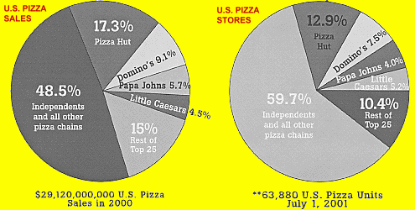


Now that the official numbers are in for 2000 and we've completed our summer census of American Pizza Stores, its time for the fourth annual PMQ midyear pizza progress report. We've scoured over the last 18 months of pizza data looking for trends, opportunities and potholes. Thank you Technomic, NPD FoodWorld, Info USA and the Franchise Finance Corporation of America for your research and help in preparing this report.
Unless you owned one of the 3,547 pizza stores that went out of business, you had a pretty good year since our report last summer. During 2000, the average pizza store had 1% fewer customers walking in the door but with an average check 5% higher. It allowed for an increase in annual sales of 4%. Average store sales at the end of the year were $4456,000. Don't relax just yet. Although you lost 3,547 of your competition, another 4904 pizza stores replaced them. The official count of U.S. pizza stores as of July 1 is 63,880.
Apparently, the relentless march of the Top 25 pizza chains has stalled and the independent operators are doing an increasingly better job of satisfying the customer. Although the average independent unit sales are much lower than their Top 25 counterparts, for the second year in a row, independents had a bigger increase in sales. In 2000, average unit sales were down $6,000 per store for the top chains while the independent managed an increase of $15,000. Top 25 sales averaged $583,000 per unit while the independent operator and all others managed yearly sales of $370,000. This last year independents were able to hold on to their share of the overall pizza industry as can be seen on the chart to your left. The Top 25 Chains presently now own 40.3% of the pizza outlets but do 51.55% of the business.
THE BIG TRENDS
The biggest trend in pizza, no doubt, is the take-and-bake concept, according to those who are opening the most new stores. Of all pizza chains that opened at least 20 stores last year, while opening more stores than the year before, two of the big three were take-and-bake operations. Papa Murphy's opened 191 stores during the last 12 months while Casey's Carryout opened another 84. The other pizza company on this short list was CiCi's Pizza who could be placed into either the budget or family niche.

| THE WINNERS | ||
| 1999-2000 | 2000/2001 | |
| Papa John | 205 | 281 |
| Papa Murphy's | 98 | 191 |
| Casey's Carryout | 71 | 84 |
| Cici's Pizza | 35 | 36 |
| *Companies opening the most stores for a net gain of pizza stores. | ||
| THE LOSERS | |
| Little Caesars | -11.26% |
| Shakey's Pizza | -7.14% |
| Mazzio's Pizza | -3.66% |
| Pizza Inn | -3.04% |
| Domino's Pizza | -0.48% |
| Sbarro's | -0.31% |
| Pizza Hut | 0.00% |
| All pizza chains with overall sales decline from 1999 to 2000. | |
Looking at the winners and losers of the industry in 2000, it is clear there has been at least a temporary reversal of fortune for the traditional leaders of the industry. What does it mean to see Pizza Hut, Domino's, Little Caesars, Pizza Inn and Sbarro's on a losers list when the industry actually had positive sales growth? It can't be explained by boardrooms that sales are just down or that it's the economy. Sales are down for some companies only while others are thriving. Customers haven't stopped buying pizza, but they are slowly changing the places from which they buy their pizza.
Clearly there are some underlying changes going on. New concepts and new approaches are needed and continue to be welcomed by the consumer. Some of the opportunities yet to be fully exploited will be impacted by other trends that have been collected here for your consideration.
MORE TRENDS EVIDENT IN 2000
CELL PHONES ARE BECOMING A FACTOR IN RESTAURANT SALES
- 41% Of adults with cell phones have placed a takeout or delivery order with them during 2000.
- 32% have used them to make dinner reservations. Source: NRA
Consumers are demanding a higher lever of service.
- 80% of food service operators report consumer expectations for quality and consistency of product and service has risen. source: Yankelovich Monitor. (Perhaps on of the reasons that independents are doing better is the fact that consumers are more likely to be in a restaurant with an active owner operator.)
Family dining is growing.
- One third of adults say they dine out more as a family than two years ago
- Kids choose the location of where to eat from 55% to 90% of the time. Source NRA
Long Term Pizza Outlook Bright
- 39% of adults cook fewer meals than they did two years ago.
- 29% of adults feel takeout is essential to the way they live.
- 47% of adults feel takeout is essential if they are between the ages of 18-24.
- 78% of households make at least one delivery or carryout purchase in a typical month.
- 44% of consumers are buying more takeout or pre-cooked meals. Source: NRA












